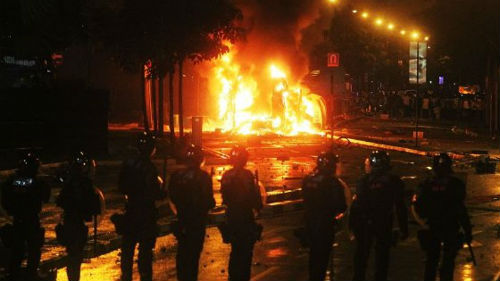The riots that took place in Little India two nights ago, was a surprise to many Singaporeans, as Singapore is well-known to be a peaceful nation comprising of a multi-racial culture.
How did the Riots break out?
Initially, the rioting started because a bus had run over and killed an Indian foreign worker, who was pinned under the bus.
To retaliate against the unfortunate bus driver’s actions, one person hit the front windscreen of the bus with a pole and the other kept hitting the bus with a rubbish bin. From there, more people joined in the violence and the rioting became quite uncontrollable.
Within a short time frame of two hours, about 400 people were involved in the rioting. In all, 18 people sustained injuries from the incident.
Rioting is of course bad, and is shocking whenever it happens especially in a peaceful society like Singapore when riots have not taken place in decades. In fact, the previous incidences of rioting in Singapore had taken place in the 1960s before our island nation gained independence.
But then, why do people even get themselves involved in such riots in the first place?
Crime of passion
People usually get involved in riots because they feel passionate about something. The feeling is not very different to the passion felt by fans at a sports event, for example, football supporters behaving violently to support their favourite club. However, even though the initial feelings are the same, riots can often get out of hand because of the level of emotions and violence taking place.
In the case of the Little India riots, the first passer-by to throw something at the bus probably felt an intense hatred and strong emotion towards the bus driver for killing a fellow human being. Racial issues could also have been involved, as after all, the victim was an Indian national and the accident had taken place in Singapore’s Little India. And because of this solitary act, more people began to join in and likewise expressed their own emotions about the incident just witnessed – thus leading to a full-blown riot.
Making A Statement
People also take part in riots because they want to make an immediate statement. They want to get noticed and rioting is a great way to do so in their eyes, because nobody can simply ignore a group of people partaking in violent behaviours.
In the case of Singapore’s Little India riots, those who were involved in the riots could have wanted to make a strong statement to the bus driver for hitting the Indian national and let him know that what he was doing was wrong. If this was the case, the intent was good, but unfortunately for them, they had gone about it in the wrong manner by partaking in violent actions themselves.
Following the Crowd
When other people see an act of violence taking place, they may also likely want to join in too because of the herd mentality that humans possess. By seeing a group of people partaking in violent actions, they may believe that it is okay to act in a similarly violent manner too. So even though they might not fully comprehend what the reason for the rioting is, they may also want to participate.
This could be a good reason why riots often get out of hand, because as more people see what is happening, they feel a strong need to “support” their fellow human beings in the violence – believing that they are doing the right thing at that point in time.
(Video from user Grimnedia, YouTube)


Leave a Comment